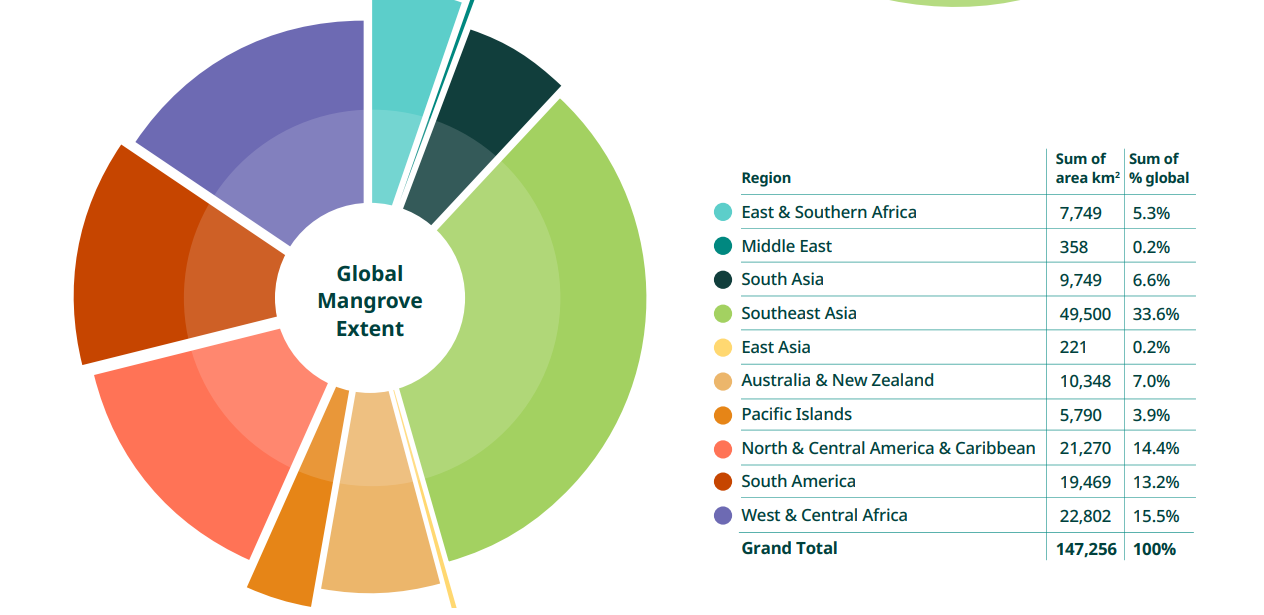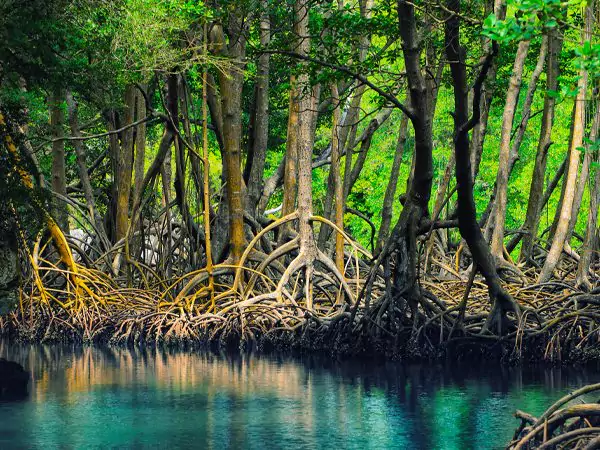IUCN Report on Mangroves: India’s Conservation Efforts & Global Protection Initiatives
Mangrove forests are one of the most productive and valuable ecosystems on Earth. They act as natural buffers against coastal erosion, provide critical habitats for marine biodiversity, and play a significant role in carbon sequestration. However, mangroves are under threat due to deforestation, coastal development, pollution, and climate change.
The International Union for Conservation of Nature (IUCN) has been actively assessing the health of mangrove ecosystems globally, with its Red List of Mangrove Ecosystems indicating that 50% of global mangrove ecosystems are at risk of collapse, categorized as Vulnerable (VU), Endangered (EN), or Critically Endangered (CR).
India, with its extensive coastline and rich mangrove ecosystems, has been implementing several conservation programs to protect these vital habitats.
Mangrove Ecosystems: Importance & Global Threats
Why Are Mangroves Important?
Mangroves are salt-tolerant trees and shrubs that grow in coastal intertidal zones across tropical and subtropical regions. These unique forests serve as critical ecological and economic assets, benefiting both biodiversity and human communities.
Key Ecological and Economic Benefits of Mangroves
- Coastal Protection & Disaster Mitigation
Mangroves form natural coastal barriers, absorbing the energy from storm surges, hurricanes, and tsunamis. Studies have shown that mangroves can reduce wave heights by up to 66%, protecting coastal communities from extreme weather events and erosion. The presence of dense root systems stabilizes coastlines, preventing land loss due to rising sea levels.
- Carbon Sequestration & Climate Change Mitigation
Mangrove forests are among the most effective carbon sinks in the world. They store three to five times more carbon per hectare than terrestrial forests, significantly contributing to blue carbon ecosystems. This makes them a crucial ally in the fight against global warming and climate change.
- Biodiversity Hotspots & Marine Nurseries
Mangroves provide habitats and breeding grounds for a vast array of marine and terrestrial species. They serve as nursery areas for commercially valuable fish, crabs, shrimps, and mollusks, supporting fisheries and marine biodiversity. They also attract birds, reptiles, and mammals, including endangered species like the Royal Bengal tiger (Sundarbans) and saltwater crocodiles.
- Livelihoods & Sustainable Fisheries
Millions of people depend on mangroves for their livelihoods, engaging in fishing, honey collection, eco-tourism, and wood harvesting. Traditional practices in Indonesia, India, and Africa rely on sustainable mangrove use for food and medicine. Protecting mangroves ensures the economic stability of these coastal communities.
- Water Filtration & Pollution Control
Mangroves act as natural filters, trapping sediments, pollutants, and heavy metals from rivers before they reach the ocean. This improves water quality and maintains the health of coral reefs and seagrass meadows, which are closely linked ecosystems.
Global Threats to Mangroves
Despite their immense ecological and economic value, mangroves are among the most threatened ecosystems worldwide. Since the 1980s, more than 35% of global mangrove forests have been lost, with some regions experiencing loss rates exceeding 50%.
Major Threats to Mangroves
Deforestation & Land Conversion
Mangroves are being cleared at alarming rates due to coastal development, agriculture, aquaculture, and urban expansion. In many regions, shrimp farming is the primary driver of mangrove destruction. Countries such as Indonesia, Thailand, Ecuador, and India have lost thousands of hectares of mangrove forests to shrimp ponds and salt farms.
Climate Change & Rising Sea Levels
Mangroves are highly sensitive to sea level rise, as they require a balance of tidal inundation and sediment deposition. Increased ocean acidification, erratic rainfall, and temperature fluctuations also disrupt their natural growth cycles, leading to forest dieback.
Pollution & Industrial Waste
Mangroves suffer from oil spills, chemical runoff, plastic pollution, and heavy metal contamination.
- Oil spills coat mangrove roots, suffocating trees and affecting marine life.
- Agricultural fertilizers and pesticides cause eutrophication, reducing oxygen levels and harming aquatic species.
- Plastic waste clogs waterways, disrupting natural water flow.
Overexploitation & Unsustainable Harvesting
Mangrove wood is highly valued for fuel, charcoal, and construction materials. Unsustainable logging leads to deforestation, reducing biodiversity and ecosystem resilience.
Invasive Species & Habitat Degradation
The introduction of invasive plant and animal species disrupts natural mangrove ecosystems. For example, invasive grasses and vines can outcompete native mangrove species, altering hydrological conditions and preventing seedling establishment.
The IUCN Red List of Mangrove Ecosystems
The International Union for Conservation of Nature (IUCN) assesses mangrove ecosystems globally under its Red List framework, categorizing them based on the risk of collapse.
Key Findings from the IUCN Red List of Mangrove Ecosystems:
- 50% of global mangrove ecosystems are threatened and classified as Vulnerable (VU), Endangered (EN), or Critically Endangered (CR).
- Countries with the most endangered mangrove forests include:
- Indonesia (home to the largest mangrove forests, but facing rapid deforestation).
- India (Sundarbans under threat due to climate change and human encroachment).
- Nigeria (oil spills and deforestation are major concerns).
- Brazil (coastal development is reducing mangrove cover).
- Conservation efforts are urgently needed to prevent further loss and degradation of these critical ecosystems.
Read the full IUCN Red List report on mangroves.
Conservation Solutions: How Can We Protect Mangroves?
Scientific Innovations in Mangrove Conservation
Satellite & Drone Monitoring:
- NASA and ESA use remote sensing to track mangrove loss and assess ecosystem health.
Blue Carbon Markets:
- Governments and private sectors are investing in carbon credit programs to incentivize mangrove conservation and restoration.
Artificial Mangrove Plantations:
- Scientists are developing bioengineering techniques to restore degraded mangrove forests.
Global Mangrove Conservation Efforts
- Global Mangrove Alliance (GMA) – A partnership of IUCN, WWF, and Conservation International, aiming to restore 15 million hectares of mangrove forests by 2030.
- The Mangrove Restoration Potential Map – A tool that identifies priority areas for mangrove restoration worldwide.
- Mangrove Action Project (MAP) – Focuses on community-based conservation, ensuring local participation in restoration projects.
India’s Mangrove Conservation Efforts: Policies, Status & Initiatives
India is home to a diverse and ecologically significant mangrove ecosystem spanning 4,992 sq. km. These vital coastal forests support biodiversity, protect shorelines, and mitigate climate change. Recognizing their importance, India has implemented several conservation policies and initiatives to ensure their protection and restoration.
Status of Mangroves in India (ISFR 2021 Report)
According to the India State of Forest Report (ISFR) 2021, India's mangrove cover has shown a net increase of 17 sq. km from 2019 to 2021.
Distribution of Mangroves in India (By State Share)
| State/Region | Mangrove Cover (%) | Key Features |
|---|---|---|
| West Bengal | 42.45% | Home to Sundarbans, the largest mangrove forest in India and a UNESCO World Heritage Site. |
| Gujarat | 23.66% | Rapid mangrove afforestation projects have helped Gujarat gain mangrove cover. |
| Andaman & Nicobar | 12.39% | Natural, undisturbed mangrove ecosystems supporting rich marine life. |
| Odisha | 8.25% | Bhitarkanika Mangroves, a Ramsar site with one of India's most intact mangrove ecosystems. |
| Maharashtra | 6.94% | Large mangrove cover along Mumbai and Konkan coastline. |
| Andhra Pradesh | 5.38% | Krishna and Godavari delta mangroves, vital for fisheries and coastal communities. |
| Tamil Nadu | 3.27% | Includes Pichavaram Mangroves, one of the world’s largest mangrove wetland ecosystems. |
India’s mangrove cover has steadily increased due to afforestation programs and stricter regulations. However, threats like urban expansion, aquaculture, and climate change remain major concerns.
Legal Protection & Conservation Policies for Mangroves in India
India has implemented several laws, policies, and conservation programs aimed at safeguarding mangroves from deforestation, industrial expansion, and habitat degradation.
Forest Conservation Act, 1980
- Prohibits the diversion of forest lands, including mangroves, for non-forestry purposes without government approval.
- Acts as a legal safeguard against encroachments and land-use changes.
Coastal Regulation Zone (CRZ) Notification, 2011
- Declares mangrove ecosystems as Ecologically Sensitive Areas (ESA), restricting development, industrial activities, and construction near them.
- CRZ-I classifies highly sensitive mangrove zones, prohibiting any human intervention except for conservation purposes.

National Mangrove Conservation Program (NMCP)
- Launched in 1987, this Centrally Sponsored Scheme
(CSS) focuses on:
- Mangrove afforestation and restoration
- Research on mangrove ecology and conservation
- Sustainable community participation in mangrove protection
- The program covers 38 mangrove sites across 10 coastal states and Union Territories.
Biodiversity Conservation Initiatives
- India has three Ramsar-listed mangrove sites:
Sundarbans (West Bengal)- Sundarbans (West Bengal)
- Bhitarkanika (Odisha)
- Gulf of Kutch (Gujarat)
- Several State Governments and NGOs run localized mangrove restoration and protection programs.
Despite these policies, illegal deforestation, pollution, and aquaculture expansion continue to pose threats to India’s mangroves. Stronger enforcement and community engagement are crucial.
MISHTI (Mangrove Initiative for Shoreline Habitats & Tangible Incomes) 2023
India’s Latest Initiative for Mangrove Conservation
Recognizing the critical role of mangroves in climate resilience and biodiversity, the Government of India launched MISHTI (Mangrove Initiative for Shoreline Habitats & Tangible Incomes) in the Union Budget 2023-24.
Objectives of MISHTI:
- Restore degraded mangroves across India's coastal states.
- Enhance carbon sequestration to mitigate climate change.
- Improve livelihoods through sustainable mangrove-based industries (fishing, eco-tourism, honey collection).
Promote biodiversity conservation and protect marine habitats.
Key Implementation Areas of MISHTI:
- Sundarbans (West Bengal) – India’s largest mangrove region, home to the Bengal tiger and diverse marine life.
- Gulf of Kutch (Gujarat) – Mangrove forests that protect Gujarat’s coastline from erosion and sea-level rise.
- Bhitarkanika (Odisha) – Ramsar-listed mangrove wetlands with India’s largest population of saltwater crocodiles.
- Krishna-Godavari Delta (Andhra Pradesh) – Important fisheries hotspot with thriving mangrove ecosystems.
- Pichavaram Mangroves (Tamil Nadu) – One of the largest mangrove wetlands in the world, supporting eco-tourism and conservation research.
Implementation Strategy of MISHTI:
- Inter-ministerial collaboration: The project is jointly managed by the Ministry of Environment, Forest & Climate Change (MoEFCC) and State Forest Departments.
- Involvement of local communities and NGOs in afforestation, livelihood programs, and eco-tourism development.
- Integration with India’s National Action Plan on Climate Change (NAPCC) to enhance climate resilience.
MISHTI is expected to create a long-term positive impact by reviving India's mangrove ecosystems, increasing coastal resilience, and supporting sustainable livelihoods.
Challenges in India’s Mangrove Conservation Efforts
Despite strong conservation policies and new initiatives like MISHTI, India faces several challenges in protecting its mangroves:
- Coastal Development & Urban Expansion: Rapid urbanization, port construction, and tourism projects lead to habitat destruction in mangrove zones.
- Aquaculture & Shrimp Farming:Unregulated shrimp farming in states like Andhra Pradesh and Tamil Nadu causes large-scale mangrove deforestation.
- Pollution & Industrial Waste:Oil spills, plastic pollution, and chemical effluents severely degrade mangrove ecosystems, especially near urban areas.
- Climate Change & Rising Sea Levels: Sea-level rise and extreme weather events pose a serious threat to low-lying mangrove forests like the Sundarbans.
- Lack of Public Awareness & Enforcement:Encroachments, illegal logging, and weak enforcement of conservation laws undermine protection efforts.
To address these challenges, India needs stronger enforcement, sustainable development strategies, and greater public participation in mangrove conservation.













